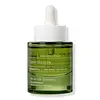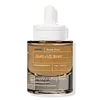What's inside
What's inside
 Key Ingredients
Key Ingredients

 Benefits
Benefits

 Concerns
Concerns

 Ingredients Side-by-side
Ingredients Side-by-side

C13-15 Alkane
SolventCocoglycerides
EmollientOctyldodecanol
EmollientIsoamyl Laurate
EmollientCoco-Caprylate
EmollientHydrogenated Ethylhexyl Olivate
EmollientAlcohol Denat.
AntimicrobialCrambe Abyssinica Seed Oil
Skin ConditioningOlea Europaea Fruit Oil
MaskingVitis Vinifera Fruit Extract
Skin ConditioningWater
Skin ConditioningAscorbyl Tetraisopalmitate
AntioxidantEthyl Linoleate
EmollientEthyl Linolenate
EmollientEthyl Oleate
EmollientEthyl Palmitate
EmollientEthyl Stearate
EmollientGlycerin
HumectantHelianthus Annuus Seed Oil
EmollientHydrogenated Olive Oil Unsaponifiables
EmollientLactic Acid
BufferingLecithin
EmollientResveratrol
AntioxidantTocopherol
AntioxidantTocopheryl Acetate
AntioxidantVitis Vinifera Seed Oil
EmollientPotassium Sorbate
PreservativeSodium Benzoate
MaskingParfum
MaskingC13-15 Alkane, Cocoglycerides, Octyldodecanol, Isoamyl Laurate, Coco-Caprylate, Hydrogenated Ethylhexyl Olivate, Alcohol Denat., Crambe Abyssinica Seed Oil, Olea Europaea Fruit Oil, Vitis Vinifera Fruit Extract, Water, Ascorbyl Tetraisopalmitate, Ethyl Linoleate, Ethyl Linolenate, Ethyl Oleate, Ethyl Palmitate, Ethyl Stearate, Glycerin, Helianthus Annuus Seed Oil, Hydrogenated Olive Oil Unsaponifiables, Lactic Acid, Lecithin, Resveratrol, Tocopherol, Tocopheryl Acetate, Vitis Vinifera Seed Oil, Potassium Sorbate, Sodium Benzoate, Parfum
Water
Skin ConditioningPentylene Glycol
Skin ConditioningSinorhizobium Meliloti Ferment Filtrate
Skin ConditioningSaccharomyces/Xylinum/Black Tea Ferment
Skin ConditioningGlycerin
HumectantAscorbyl Palmitate
AntioxidantAvena Sativa Kernel Extract
AbrasiveBenzyl Alcohol
PerfumingBrassica Napus Extract
Skin ConditioningButylene Glycol
HumectantCetyl Hydroxyethylcellulose
Emulsion StabilisingEpigallocatechin Gallate
AntioxidantEpigallocatechin Gallatyl Glucoside
AntioxidantEthylhexylglycerin
Skin ConditioningGlyceryl Acrylate/Acrylic Acid Copolymer
HumectantHelianthus Annuus Seed Oil
EmollientHexapeptide-11
Skin ConditioningHydrolyzed Sodium Hyaluronate
Skin ConditioningHydrolyzed Soybean Fiber
Skin ProtectingHydroxyethylcellulose
Emulsion StabilisingLactic Acid
BufferingLecithin
EmollientParfum
MaskingPeucedanum Graveolens Extract
TonicPhenoxyethanol
PreservativePinus Nigra Bud/Needle Extract
AntimicrobialPolyacrylate Crosspolymer-6
Emulsion StabilisingPolyglyceryl-5 Laurate
EmulsifyingPotassium Sorbate
PreservativeSodium Benzoate
MaskingSodium Carboxymethyl Beta-Glucan
CleansingSodium Dehydroacetate
PreservativeSodium Hyaluronate
HumectantTetrasodium Glutamate Diacetate
Tocopherol
AntioxidantXanthan Gum
EmulsifyingWater, Pentylene Glycol, Sinorhizobium Meliloti Ferment Filtrate, Saccharomyces/Xylinum/Black Tea Ferment, Glycerin, Ascorbyl Palmitate, Avena Sativa Kernel Extract, Benzyl Alcohol, Brassica Napus Extract, Butylene Glycol, Cetyl Hydroxyethylcellulose, Epigallocatechin Gallate, Epigallocatechin Gallatyl Glucoside, Ethylhexylglycerin, Glyceryl Acrylate/Acrylic Acid Copolymer, Helianthus Annuus Seed Oil, Hexapeptide-11, Hydrolyzed Sodium Hyaluronate, Hydrolyzed Soybean Fiber, Hydroxyethylcellulose, Lactic Acid, Lecithin, Parfum, Peucedanum Graveolens Extract, Phenoxyethanol, Pinus Nigra Bud/Needle Extract, Polyacrylate Crosspolymer-6, Polyglyceryl-5 Laurate, Potassium Sorbate, Sodium Benzoate, Sodium Carboxymethyl Beta-Glucan, Sodium Dehydroacetate, Sodium Hyaluronate, Tetrasodium Glutamate Diacetate, Tocopherol, Xanthan Gum
 Reviews
Reviews

Ingredients Explained
These ingredients are found in both products.
Ingredients higher up in an ingredient list are typically present in a larger amount.
Glycerin is already naturally found in your skin. It helps moisturize and protect your skin.
A study from 2016 found glycerin to be more effective as a humectant than AHAs and hyaluronic acid.
As a humectant, it helps the skin stay hydrated by pulling moisture to your skin. The low molecular weight of glycerin allows it to pull moisture into the deeper layers of your skin.
Hydrated skin improves your skin barrier; Your skin barrier helps protect against irritants and bacteria.
Glycerin has also been found to have antimicrobial and antiviral properties. Due to these properties, glycerin is often used in wound and burn treatments.
In cosmetics, glycerin is usually derived from plants such as soybean or palm. However, it can also be sourced from animals, such as tallow or animal fat.
This ingredient is organic, colorless, odorless, and non-toxic.
Glycerin is the name for this ingredient in American English. British English uses Glycerol/Glycerine.
Learn more about GlycerinHelianthus Annuus Seed Oil is the oil derived from the seeds of a Sunflower. Sunflower seed oil is non-fragrant. It is an emollient, meaning it helps to soften the skin.
Sunflower seed oil contains many fatty acids. The fatty acids found in sunflower seeds include (from highest amount to least): linoleic acid, myristic acid, palmitic acid, stearic acid, arachidic acid, oleic acid, and linolenic acid.
These fatty acids help the skin create ceramides. Ceramides play a role in repairing the skin barrier.
Helianthus Annuus Seed Oil helps moisturize the skin. This in turn helps the skin look more rejuvenated and smoother.
Sunflowers are rich in vitamin E.
Historians believe Indigenous cultures of North America domesticated sunflowers before corn. Thus they relied on sunflower oil for a variety of uses. One such use is moisturizing skin and hair.
Sunflower seed oil may not be fungal acne safe. We recommend speaking with a professional if you have any concerns.
Learn more about Helianthus Annuus Seed OilLactic Acid is another well-loved alpha hydroxy acid (AHA). It is gentler than glycolic acid but still highly effective.
Its main role is to exfoliate the surface of the skin by loosening the “glue” that holds dead skin cells together. Shedding those old cells leads to smoother, softer, and more even-toned skin.
Because lactic acid molecules are larger than glycolic acid, they don’t penetrate as deeply. This means they’re less likely to sting or irritate, making it a great choice for beginners or those with sensitive skin.
Like glycolic acid, it can:
Lactic acid also acts as a humectant (like hyaluronic acid). It can draw water into the skin to improve hydration and also plays a role in the skin's natural moisturizing factor (NMF) in the form of sodium lactate.
Studies show it can boost ceramide production to strengthen the skin barrier and even help balance the skin’s microbiome.
To get results, choose products with a pH between 3-4.
Lower strengths (5-12%) focus on surface exfoliation; higher strengths (12% and up) can reach deeper in the dermis (deeper, supportive layer) to improve skin texture and firmness over time.
Though it was originally derived from milk, most modern lactic acid used in skincare is vegan. It is made through non-dairy fermentation to create a bio-identical and stable form suitable for all formulations.
When lactic acid shows up near the end of an ingredient list, it usually means the brand added just a tiny amount to adjust the product’s pH.
Legend has it that Cleopatra used to bathe in sour milk to help reduce wrinkles.
Lactic acid is truly a gentle multitasker: it exfoliates, hydrates, strengthens, and brightens. It's a great ingredient for giving your skin a smooth, glowing, and healthy look without the harshness of stronger acids.
Read more about some other popular AHA's here:
Learn more about Lactic AcidLecithin is a term for a group of substances found in the cell membranes of plants, animals, and humans. They are made up of mixture of phospholipids.
This ingredient has emollient and emulsifying properties.
As an emollient, lecithen helps soften the skin and creates a barrier to keep moisture in.
As an emulsifier, it also helps prevent water and oil ingredients from separating. Lecithin can also help ingredients be better absorbed by the skin.
This is because the phospholipids in lecithin produce liposomes. Liposomes help other ingredients get through the skin barrier.
Depending on the source of this ingredient, lecithin may not be fungal acne safe. This is because some sources of lecithin come from soybean oil, which may feed the malassezia yeast that feeds fungal acne.
We recommend reaching out to the brand you are purchasing from to inquire about the source of their lecithin.
Some other names for this ingredient include soy lecithin and deoiled soy lecithin.
Learn more about LecithinParfum is a catch-all term for an ingredient or more that is used to give a scent to products.
Also called "fragrance", this ingredient can be a blend of hundreds of chemicals or plant oils. This means every product with "fragrance" or "parfum" in the ingredients list is a different mixture.
For instance, Habanolide is a proprietary trade name for a specific aroma chemical. When used as a fragrance ingredient in cosmetics, most aroma chemicals fall under the broad labeling category of “FRAGRANCE” or “PARFUM” according to EU and US regulations.
The term 'parfum' or 'fragrance' is not regulated in many countries. In many cases, it is up to the brand to define this term.
For instance, many brands choose to label themselves as "fragrance-free" because they are not using synthetic fragrances. However, their products may still contain ingredients such as essential oils that are considered a fragrance by INCI standards.
One example is Calendula flower extract. Calendula is an essential oil that still imparts a scent or 'fragrance'.
Depending on the blend, the ingredients in the mixture can cause allergies and sensitivities on the skin. Some ingredients that are known EU allergens include linalool and citronellol.
Parfum can also be used to mask or cover an unpleasant scent.
The bottom line is: not all fragrances/parfum/ingredients are created equally. If you are worried about fragrances, we recommend taking a closer look at an ingredient. And of course, we always recommend speaking with a professional.
Learn more about ParfumPotassium Sorbate is a preservative used to prevent yeast and mold in products. It is commonly found in both cosmetic and food products.
This ingredient comes from potassium salt derived from sorbic acid. Sorbic acid is a natural antibiotic and effective against fungus.
Both potassium sorbate and sorbic acid can be found in baked goods, cheeses, dried meats, dried fruit, ice cream, pickles, wine, yogurt, and more.
You'll often find this ingredient used with other preservatives.
Learn more about Potassium SorbateSodium Benzoate is a preservative. It's used in both cosmetic and food products to inhibit the growth of mold and bacteria. It is typically produced synthetically.
Both the US FDA and EU Health Committee have approved the use of sodium benzoate. In the US, levels of 0.1% (of the total product) are allowed.
Sodium benzoate works as a preservative by inhibiting the growth of bacteria inside of cells. It prevents the cell from fermenting a type of sugar using an enzyme called phosphofructokinase.
It is the salt of benzoic acid. Foods containing sodium benzoate include soda, salad dressings, condiments, fruit juices, wines, and snack foods.
Studies for using ascorbic acid and sodium benzoate in cosmetics are lacking, especially in skincare routines with multiple steps.
We always recommend speaking with a professional, such as a dermatologist, if you have any concerns.
Learn more about Sodium BenzoateTocopherol (also known as Vitamin E) is a common antioxidant used to help protect the skin from free-radicals and strengthen the skin barrier. It's also fat soluble - this means our skin is great at absorbing it.
Vitamin E also helps keep your natural skin lipids healthy. Your lipid skin barrier naturally consists of lipids, ceramides, and fatty acids. Vitamin E offers extra protection for your skin’s lipid barrier, keeping your skin healthy and nourished.
Another benefit is a bit of UV protection. Vitamin E helps reduce the damage caused by UVB rays. (It should not replace your sunscreen). Combining it with Vitamin C can decrease sunburned cells and hyperpigmentation after UV exposure.
You might have noticed Vitamin E + C often paired together. This is because it is great at stabilizing Vitamin C. Using the two together helps increase the effectiveness of both ingredients.
There are often claims that Vitamin E can reduce/prevent scarring, but these claims haven't been confirmed by scientific research.
Learn more about TocopherolWater. It's the most common cosmetic ingredient of all. You'll usually see it at the top of ingredient lists, meaning that it makes up the largest part of the product.
So why is it so popular? Water most often acts as a solvent - this means that it helps dissolve other ingredients into the formulation.
You'll also recognize water as that liquid we all need to stay alive. If you see this, drink a glass of water. Stay hydrated!
Learn more about Water